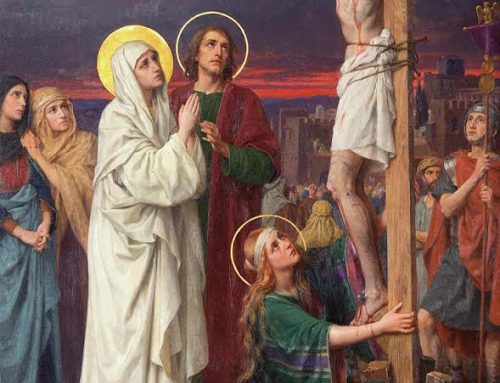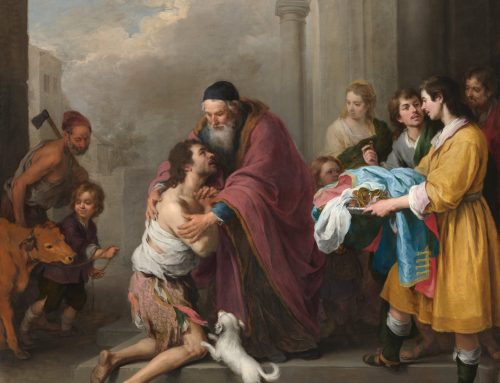
Mary sits enthroned in heaven on the right hand of Jesus Christ, who crowns her as “Queen of Heaven” in this 13th century apse mosaic in the Santa Maria Maggiore, Rome.
The Davidic Kingdom covenant as expressed in the Old Testament has an interesting feature which carries through to the New Covenant era, the Queen Mother. The Queen Mother, or the gebirah (‘great lady’ in Hebrew), is featured in the Old Testament as an exalted position of honor. In the Davidic Kingdom, there could be multiple queens because kings often had a myriad of wives. The king, however, had only one mother; it was through his mother that his lineage was authenticated. The mother of the king was a position of honor and one of intercession with the king on behalf of the people.
Bathsheba, one of King David’s many wives, was Solomon’s mother. In this scene recorded in the first book of Kings, Bathsheba approaches King Solomon to intercede on behalf of Adonijah. We read in I Kings 2:19:
So, Bathsheba went to King Solomon, to speak to him on behalf of Adonijah. And the king rose to meet her and bowed down to her; then he sat on his throne, and had a seat brought for the king’s mother; and she sat on his right.
Notice that King Solomon rises to meet her, he bows, and then he has a throne brought for her to sit at his right hand, a position in ancient times suggesting one of power and authority, second only to the king. Reading further in I Kings 2, Bathsheba says, “I have one small request to make of you; do not refuse me.” And the king said to her, “Make your request, my mother; for I will not refuse you” (I Kings 2:20). Ultimately, King Solomon does not uphold this particular request; yet we see the king listening to his mother and exalting her to a place of importance. The text clearly indicates her intercessory duties.
In the New Covenant era, Christ, the son of David, establishes a New Kingdom with a new Queen Mother, the Blessed Virgin Mary, who is crowned and seated in a place of honor, interceding between the King and the subjects. Just as with queen mothers of the Old Testament, Mary is “wearing a crown of 12 stars” (Rev 12:1) and sits at the right hand of Jesus in heaven, interceding on our behalf. We first see Mary’s intercession at the Wedding Feast at Cana (John 2). When those hosting the party run out of wine, she notifies Jesus who tells her it’s not yet His time, but performs the miracle of water to wine anyway, saving the hosts from societal scandal. If Mary is the new Queen Mother, then it makes sense we would honor her-not worship her-and ask her to intercede for us with her Son. As the new Solomon, Christ honors His mother with a place in heaven; He hears her requests and does not refuse her. Her will is perfectly aligned with His. In other words, she’s not asking Jesus for your team to win the game. She requests of her Son things that good mothers want for their children, everlasting things, things which are good, true, and beautiful, things which lead us to Christ.
As we approach the Feast of Pentecost, the birth of the Church, we can think back to the Upper Room on the First Pentecost. The first bishops and pope were there, but so was the Mother of God. Mary was praying with the Church. As the Vatican II document Lumen Gentium teaches, Mary was “by her prayers, imploring the gift of the Spirit, who had already overshadowed her in the Annunciation” (Lumen Gentium, 59). She prays for the Church, for you and for me, as the exalted Queen of Heaven, that we might be more fully conformed to her Son, the King of Kings. May we make the prayer of St. Ephrem our own. “Majestic and Heavenly Maid, Lady, Queen, protect and keep me under your wing lest Satan the sower of destruction glory over me, lest my wicked foe be victorious against me.” (St. Ephrem, the Syrian, 4th century).





Leave A Comment